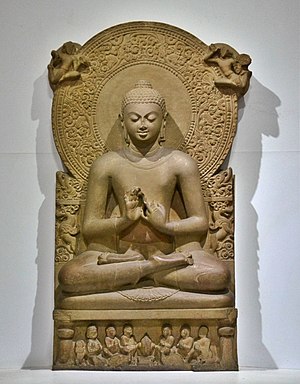 We continue from last week with the The Power of Nonviolence: Writings by Advocates of Peace provides us with the Peace Book Chapter of the Week. As you remember we discussed last week the introduction by Howard Zinn titled Retaliation. We now move to the first section of the book which is entitled: Pre-Twentieth Century. The first, very short chapter is written by the Buddha, and is entitled: Let a Man Overcome Anger by Love.
We continue from last week with the The Power of Nonviolence: Writings by Advocates of Peace provides us with the Peace Book Chapter of the Week. As you remember we discussed last week the introduction by Howard Zinn titled Retaliation. We now move to the first section of the book which is entitled: Pre-Twentieth Century. The first, very short chapter is written by the Buddha, and is entitled: Let a Man Overcome Anger by Love.
For hatred does not cease
by hatred at any time,
hatred ceases by love
The reading starts with a series of aphorisms about how you are bound by what you put forth. It reminds me of the saying that slavery chains both the master and the slave. Or Gandhi’s response about how he was trying to save England by freeing it from holding India in bondage. The third set of aphorisms set here as a pull quote remind me strongly of Dr. King’s August 16, 1967 “Where Do We Go From Here?” when he spoke out against poverty:
And the other thing is, I’m concerned about a better world. I’m concerned about justice; I’m concerned about brotherhood; I’m concerned about truth. And when one is concerned about that, he can never advocate violence. For through violence you may murder a murderer, but you can’t murder murder. Through violence you may murder a liar, but you can’t establish truth. Through violence you may murder a hater, but you can’t murder hate through violence. Darkness cannot put out darkness; only light can do that. And I say to you, I have also decided to stick with love, for I know that love is ultimately the only answer to mankind’s problems.
Speaking about love in such strong terms can cause a strong reactions. King was vilified in all the media of his day for economic speeches and especially for his anti-war speeches of the same year. Even today, they are not taught. As the Duchess and I were told once by a Native American flutist, when you create something beautiful you draw to you the positive and the negative. As the Duke quoted in last week’s discussion on Zinn’s introduction:
it proposes not passivity but resistance, a resistance that, because it is nonviolent, has a unique power that is greater than the power of guns and bombs.
The second half of the chapter continues with the following quote directly from the Buddha, and a parable to explain it:
If a man foolishly does me wrong, I will return to him the protection of my ungrudging love; the more evil comes from him, the more good shall go from me, the fragrance of goodness goes to me, and the harmful air of evil goes to him.
With a smile, the Duke is reminded of the playground taunt that:
I am rubber
and you are glue,
whatever you say
bounces off me
and sticks to you
The Buddha more elegantly tells the parable of the man who comes to tests the Buddha’s resolve to answer hate with love. when the man has finished his tirade, the Buddha asks him what happens to a gift when the intended recipient does not accept it . the man replies that the giver is left holding the gift. And the Buddha explains that he will not accept the man;s anger, so the man is left holding it. Implicit in this is that if the man will not accept the Buddha’s love, then the Buddha retains love.
 This is a beautiful sentiment, but the Duke admits that it takes a great deal of work to learn how to follow it in real life. Though it is where we would all like to be, it is not how we are acculturated to deal with hate. Two books that we previously discussed will help on this path: Nonviolent Communication by Marshall Rosenberg. and Practicing Peace in Times of War by Pema Chödrön.
This is a beautiful sentiment, but the Duke admits that it takes a great deal of work to learn how to follow it in real life. Though it is where we would all like to be, it is not how we are acculturated to deal with hate. Two books that we previously discussed will help on this path: Nonviolent Communication by Marshall Rosenberg. and Practicing Peace in Times of War by Pema Chödrön.
Next week’s chapter is by William Penn.
Related articles
- Power of Nonviolence Zinn-troduction: Peace Book Chapter of the Week 9/12/11 (peacecouple.com)
- Thich Nhat Hanh Royal Comic Book of the Week: Monday 9/5/11 (peacecouple.com)
- Royal Book of the Week: Monday 8/8/11 (peacecouple.com)
- Book of the Week: Monday 7/24/11 (peacecouple.com)


